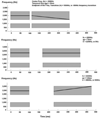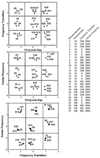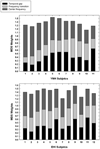Classification and cue weighting of multidimensional stimuli with speech-like cues for young normal hearing and elderly hearing-impaired listeners
- PMID: 18596642
- PMCID: PMC3204376
- DOI: 10.1097/AUD.0b013e31817bdd42
Classification and cue weighting of multidimensional stimuli with speech-like cues for young normal hearing and elderly hearing-impaired listeners
Abstract
Objective: The purpose of this study was to investigate how young normal-hearing (YNH) and elderly hearing-impaired (EHI) listeners make use of redundant speech-like cues when classifying nonspeech sounds having multiple stimulus dimensions.
Design: A total of four experiments were conducted with 10 to 12 listeners per group in each experiment. There were 27 stimuli, making use of all possible combinations of three stimulus values along each of three cue dimensions. Stimuli were comprised of two brief sequential noise bursts separated by a temporal gap. Stimulus dimensions were: (1) the center frequency of the noise bursts; (2) the duration of the temporal gap separating the noise bursts; and (3) the direction of a frequency transition in the second noise burst.
Results: Experiment 1 verified that the stimulus values selected resulted in adjacent steps along each stimulus being easily discriminable [(P(c) > or = 90%]). In experiment 2, similarity judgments were obtained for all possible pairs of the 27 stimuli. Multidimensional scaling confirmed that the three acoustic dimensions existed as separate dimensions perceptually. In experiment 3, listeners were then trained to classify three exemplar stimuli. After the training, they were required to classify all 27 stimuli and these results led to the derivation of attentional weights for each stimulus dimension. Both groups focused their attention on the frequency-transition dimension during the classification task. Finally, experiment 4 demonstrated that the attentional weights derived in experiment 3 were reliable and that both EHI and YNH participants could be trained to shift their attention to a cue dimension (temporal-gap) not preferred in experiment 3, although older adults required much more training to achieve this shift in attention.
Conclusion: For the speech-like, multidimensional acoustic stimuli used here, YNH and EHI listeners attended to the same dimensions of the stimuli when classifying them. In general, the EHI listeners required more time to acquire the ability to categorize the stimuli, and to change their focus to alternate stimulus dimensions.
Figures












Similar articles
-
Word recognition for temporally and spectrally distorted materials: the effects of age and hearing loss.Ear Hear. 2012 May-Jun;33(3):349-66. doi: 10.1097/AUD.0b013e318242571c. Ear Hear. 2012. PMID: 22343546
-
Identification of multidimensional stimuli containing speech cues and the effects of training.J Acoust Soc Am. 1997 Oct;102(4):2297-310. doi: 10.1121/1.419639. J Acoust Soc Am. 1997. PMID: 9348688
-
Contribution of high frequencies to speech recognition in quiet and noise in listeners with varying degrees of high-frequency sensorineural hearing loss.J Speech Lang Hear Res. 2007 Aug;50(4):819-34. doi: 10.1044/1092-4388(2007/057). J Speech Lang Hear Res. 2007. PMID: 17675588
-
Measuring the effects of reverberation and noise on sentence intelligibility for hearing-impaired listeners.J Speech Lang Hear Res. 2010 Dec;53(6):1429-39. doi: 10.1044/1092-4388(2010/09-0197). Epub 2010 Aug 5. J Speech Lang Hear Res. 2010. PMID: 20689027
-
Dissociating speed and accuracy in absolute identification: the effect of unequal stimulus spacing.Psychol Res. 2009 May;73(3):308-16. doi: 10.1007/s00426-008-0158-2. Epub 2008 Aug 13. Psychol Res. 2009. PMID: 18704493 Review.
Cited by
-
Individual sensitivity to spectral and temporal cues in listeners with hearing impairment.J Speech Lang Hear Res. 2015 Apr;58(2):520-34. doi: 10.1044/2015_JSLHR-H-14-0138. J Speech Lang Hear Res. 2015. PMID: 25629388 Free PMC article.
-
Does the Speech Cue Profile Affect Response to Amplitude Envelope Distortion?J Speech Lang Hear Res. 2021 Jun 4;64(6):2053-2069. doi: 10.1044/2021_JSLHR-20-00481. Epub 2021 May 21. J Speech Lang Hear Res. 2021. PMID: 34019777 Free PMC article.
-
Reliability and Repeatability of the Speech Cue Profile.J Speech Lang Hear Res. 2018 Aug 8;61(8):2126-2137. doi: 10.1044/2018_JSLHR-H-17-0341. J Speech Lang Hear Res. 2018. PMID: 30073277 Free PMC article.
References
-
- American National Standards Institute. Maximum permissible ambient noise levels for audiometric test rooms. (ANSI S3.1-1991) New York: ANSI; 1991.
-
- American National Standards Institute. Specifications for audiometers. (ANSI S3.6-1996) New York: ANSI; 1996.
-
- Ballas JA. Common factors in the identification of an assortment of brief everyday sounds. Journal of Experimental Psychology: Human Perception and Performance. 1993;19:250–267. - PubMed
-
- Christensen LA, Humes LE. Identification of multidimensional stimuli containing speech cues and the effects of training. Journal of the Acoustical Society of America. 1997;102:2297–2310. - PubMed
-
- Corso JF. Age and sex differences in pure tone thresholds: survey of hearing levels from 18 to 65 years. Archives of Otolaryngology. 1963;77:385–405. - PubMed
Publication types
MeSH terms
Grants and funding
LinkOut - more resources
Full Text Sources
Medical
Miscellaneous

